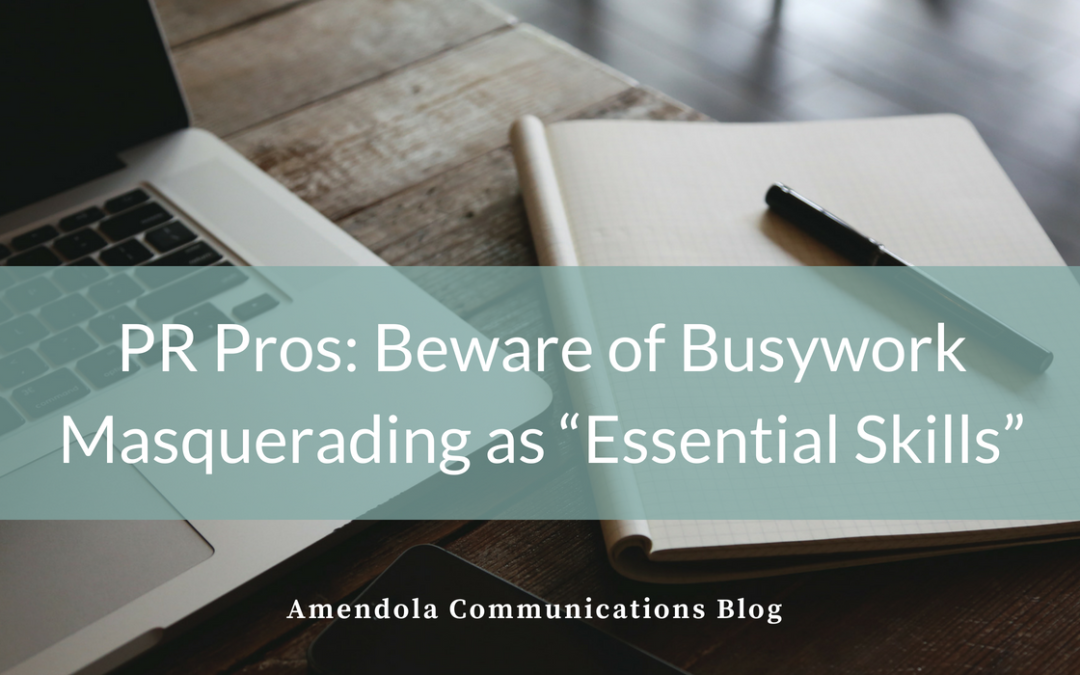
by Stephanie Janard | May 23, 2018 | Blog
Some hard truths on the PR skills we really should be developing for our clients and our own professional development.
A well-known public relations trade site recently ran a “listicle” of so-called essential PR skills for our modern technology-driven era. Included in the list were graphic design, analytics, and even some light HTML coding.
My first reaction was moderate panic. Analytics, I totally get. But today’s PR professionals should now be expected to design collateral, tweak the coding for HTML email blasts and websites, in addition to establish a media presence, build brand awareness and help generate leads for our clients?
Well, being the people-pleasing, “I can take that on!” person so many of us in PR are, I was on the verge of heading over to Coursera when, thankfully, a second reaction kicked in: revolt.
Here’s the reality. Most of us, whether we work in an agency or in-house, already spend way too much time pecking away at keyboards on any number of non-creative tasks, much of it on the administrative end of managing public relations. Add to this an interminable stream of emails to write and respond to, and collectively, these tasks suck up more of our work week than we’d ever want to admit.
Meanwhile, on the in-house side, marketing and PR are increasingly a “catchall” destination for other departments that want to pretty up a presentation, proofread a legal document, properly format a PDF, mail merge an email, and other “this should just take a few minutes” requests that create a lot of job creep and regularly push pressing marketing and PR projects to the back burners.
People, God HELP us if we add coding and graphic design to our never-ending “I can do that!” lists. And heaven help our clients, whether in-house or on the agency side. As we continue to get mired down in busywork, fresh ideas for PR and marketing either won’t get thought of, or will lose their potential in poorly executed campaigns.
Besides, the world is full of poorly designed marketing collateral and glitchy apps. Perhaps because we’re getting what we pay for? Let’s pay for highly skilled professionals who specialize in the high skilled work of graphic design and coding. Not pass it on to a PR or marketing professional who can do just enough to get the job done, but not very creatively.
That way, we can stay focused on continuously improving the following marketing and PR skills.
#1: More persuasively make the case for bold creativity. It’s the only kind of messaging that breaks through, yet it remains difficult to convince clients even sometimes our own account teams to take a risk with provocative messaging and concepts. This is something learned over time and with practice, but here are a few pointers: have examples at the ready of successful campaigns that used unusual or daring messaging; bring the client in on the creative process; and particularly for B2b PR and marketing–don’t be afraid to challenge the conventional thinking that B2b buyers are a conservative market who just want the facts. These people respond to humor and provocative messaging just like the rest of us humans.
It also helps to foster creativity among your team or even better as a company value. Check out this collection of tips from an article I once wrote about inspiring creativity in the attractions and entertainment industries–where regularly unleashing the “wow factor” is a mandate.
#2: Out-argue the lawyers. While legal expertise is needed in many companies, it is often applied to marketing and PR projects with massive overkill. Time after time I’ve seen press releases, bylines, reports, and other copy utterly diluted of any potential impact after a single legal marketing review.
I’m also convinced it was the lawyers at United who advised the CEO to refer to a bloodied, brutalized passenger being dragged off the plane as being “re-accommodated.” No self-respecting PR pro would have greenlighted this horrendous understatement. They also would have predicted that any financial settlement would be a fraction of the billions of dollars in market value lost in the wake of such a dreadful response. A hard lesson learned for United, but one PR departments everywhere can have on hand to bring up in any future debates with legal.
#3: Client relations. Investing in PR isn’t cheap, whether working with an agency or hiring an in-house team. Company leaders are often nervous about what to expect and how they will measure results. Often this is driven by anxiety over a business objective they are directly responsible for achieving. And all clients are different with their own working and communication styles, and criteria for success. We must be able to put ourselves in many different pairs of shoes.
I can’t overstate how important regular communication with clients is to achieve this state of empathetic nirvana. It is the only way to keep a pulse on our clients current concerns and long term needs, both of which good PR people should always have a read on. Busywork can suck us away from these needed conversations. Don’t let it.
#4: Setting the stage for a story. I have blatantly ripped this off from a Wired article about one of the most powerful PR pros in Silicon Valley whose chief skill is not coding or graphic design. It is, as the article noted, creating a memorable scene for a story. So think. The next time we’re pitching, what is the perfect analogy or metaphor to help explain our angle? If a meeting with a journalist will be in-person, what might be a memorable location that underscores what we want to convey?
Again, mired down in busywork takes away the needed time to conceptualize and create such settings. Which costs us dearly in unforgettable media coverage.
#5: Write better headlines. It doesn’t have to be clickbait, but the opposite end of the spectrum is just as obnoxious–those plodding, painful headlines that make use of tired corporates-peak like “ensure” and “leverage” and “enhance.” Shooting for brevity can help alleviate these tendencies, so keep press release titles to 10 words or less, email subject lines to 4 words or less.
#6: Figure out what makes buyers tick. And when. We must insist on having the time to create (or the money to hire someone to create) buyer personas and buyer journeys, to conduct customer interviews, and whatever it takes to know our clients target customer audiences inside and out. It is the difference in good versus scant PR results. And so here I will freely admit that yes, basic analytics is an essential skill, unless you have a department that does this for you. Many of us don’t, alas.
#7: Demand generation. We all know by now that most buyers of big ticket items have made up their minds on who they’re buying from before they reach out to a vendor. So it remains critical to get the right information to them at the right time. Demand generation, content marketing, whatever you want to call it ““ we do need to understand the basics, even if we hire outside firms to put together the logistics for our demand generation/content marketing programs.
#8: Measure results. PR continues to be difficult to link to sales, but there are metrics we should follow and get versed in that help us better connect the dots. Really partner with your client on this, or if you work in-house, with your marketing analytics people. One of my clients has built a special analytics dashboard that shows website traffic by customizable time frames, and where the traffic comes from. I’m able to easily correlate press release and published bylines with spikes in traffic, plus show traffic increase comparisons year over year or month-by-month.
If you don’t have all of the above skills down cold, don’t panic neither do most of us. But getting rid of unproductive goals will make sure we have more time to become experts in these and other skills that matter most.

by Stephanie Janard | Nov 29, 2017 | Blog
One of these days I’m going to put together a sort of “Road Warrior Olympics,” in which contestants compete on how well they can conduct business while riding in an Uber, going through security at the airport, and even in the midst of the plane’s takeoff and landing. That’s how impressed I am with the multitasking skills of the thought leader healthcare executives I regularly interview for various writing projects. I probably have more interviews with people driving to the airport than I do while they’re in an actual office building.
Just last week, I interviewed the CEO of an operating room analytics company while his Uber driver took him to Heathrow. Just as he was arriving at the airport, he discovered his flight was actually leaving from a different airport. He was only momentarily at a loss for words then crisply told me he’d call me right back. Expecting it to be more like a day, I wished him good luck getting on his flight.
Five minutes later, my phone rang. The CEO was back on track to the right airport and we picked up where we’d left off.
These are the dream accounts the ones where thought leaders are actually available to share their thoughts with the writer who will create a byline or case study that’s hopefully as compelling as the way the thought leader made his or her points. I cannot overstate the importance of having access to these people.
Yes, a preliminary brief on the topic is a good starting point. But in my experience, when information is transmitted through multiple middlepersons, the thought leader inevitably reads what was written and either deems it way off track or missing key points.
If you are the person who is the main liaison with your PR agency, resist the temptation to take the following shortcuts which I’ve put in the format of some common excuses for blocking writer access to thought leaders:
“She’s just too busy. Can I just give you the salient points and you can dash a quick byline off?”
At this point in my career, I probably can do this more or less effectively. But something will be missing: the thought leader’s voice and latest insights. The information that a skilled interviewer which PR agency writers must be, and that’s non-negotiable knows how to draw out of even the most reticent interviewee.
Also, you are presumably paying good money for the services of a professional writer. Why not get all the value you can from your investment? Blocking the writer from an interview that would likely result in a much better byline, simply for the sake of convenience and speed, is like filling up on all the cheap starches at buffet instead of selecting the more delectable treats.
“It takes us so long to get writing projects through the review queue. Let’s just use language that’s already approved.”
You mean that language that’s staler than a loaf of bread with a missing zip tie that’s been sitting on a kitchen counter for over a week? This is marketing messaging suicide. Just like other departments in the business, marketing must be able to move nimbly. If it really takes that long to get projects approved, you must fight for a more streamlined process. Or else your marketing department will become known as the graveyard for ideas.
Can we write a byline based on these three or four existing pieces? That way we won’t have to interview anyone.” This is similar to the above scenario. And sure, I can do it, but again you’re wasting the resources of a professional writer by basically having them do assembly line work. You could hire an el cheapo content mill writer instead if all you really need is to put a donkey’s tail on a fish’s head.
Now some thought leaders themselves are the cause of the block. Perhaps they are under the impression they are too busy or are just too inexperienced at being a thought leader. They may not be the right thought leaders for you to develop. But sometimes it just takes an interesting interview and byline to get these promising thought leaders on board. Some tips for finding their thought leadership mojo can be found here and here.
Another benefit for these newbies is that interviewing with a writer is great practice for subsequent interviews with the media.
What writers should bring to the table
Thought leadership time is valuable, and writers should make the most of it. Here is what a thought leadership should expect from a writer:
- An advance idea of questions if possible. This gives the thought leader time to process and give thought to what will be under discussion. Of course, the conversation doesn’t have to stick exactly to these questions. But the thought leader should go into the conversation with more than just a broad idea about what will be discussed.
- An opportunity to review the proposed draft. These are your words, your ideas, your thoughts. It’s also your name on the byline. As such, you deserve to have the opportunity to review all drafts, especially the final set for publication. I’ve seen a byline author horrified when a piece he didn’t sanction get published with inaccurate information which was called out by industry peers. (Obligatory side note: it wasn’t a piece I wrote. In fact, it was the impetus for bringing us on board.)
- Openness to giving and receiving feedback. This is your byline. Let the writer know if that isn’t your voice or if points are incorrect or missing or need further clarification. But resist the urge to “just write it yourself.” That’s like hiring a chef to cook you a meal and then going in and adjusting the seasoning yourself. Tell them what you want. If they are a professional, they can do it. In my experience, fewer drafts result when reviewers contain their edits to comments in the margins.
To recap: a good writer is a budding thought leader’s best asset. Rather than keep them apart, foster this relationship to the fullest extent you can. Soon your thought leader will leap from “budding” to “champion” and not just of the Road Warrior Olympics.

by Julie Donnelly | Oct 25, 2017 | Blog
There is a persistent stereotype of public relations professionals as “spin doctors.” We’re hired guns aiming to put lipstick on a pig, pull the wool over someone’s eyes, or <insert any other cliched maxim here>. The last thing we would do is tell clients to lead with empathy, telling honest stories from the heart.
In truth, PR folks want to help companies clarify, amplify and distribute their message and their mission. Often, innovators are too close their own products to effectively tell their own stories. To speak for them, PR people must first understand what drives the company from its origin story to the everyday passions of the company’s employees.
Listening is the most important skill in PR. Empathy is the most important mindset. And nowhere is this as vital as within the healthcare industry.
Hundreds of thousands of people work across the American healthcare system with a single, shared goal: to help people. It is easy to lose sight of this. Insurers, hospitals, life sciences companies, health tech startups and other healthcare vendors struggle to respond to a buffet of financial and regulatory challenges that are amplified by the current transformation to value-based care.
One Boston hospital CEO described it best when she said that the biggest struggle for most healthcare organizations is “having one foot in the boat and one foot on the dock.” Many providers have made significant strides towards goals such as shifting to pay-for-performance contracts, launching population health programs, or modernizing their payment systems to reflect consumer-driven health plans. But extending clinical and patient experience best practices to every last patient remains an elusive goal for most.
It is fair to say that our healthcare company clients all have one thing in common they are all working to help healthcare providers (or insurers or employers) to get “both feet into the boat” when it comes to value-based care. Understanding the importance of this mission, and its inherent challenges, is our first job as healthcare PR professionals.
Our second job is to help clients to lead with empathy, by guiding them back, again and again, to their core value helping customers tackle the goals of the Triple Aim. Here are three ways healthcare companies can cut to the core of what matters, tell their company story effectively, and gain customer loyalty:
Everyone is a patient
Some of the most effective and memorable client communications I have seen draw on the healthcare experiences of CEOs, other C-suite executives, researchers, other employees, or their families. We all have stories of instances when the healthcare system has not delivered on its promise, and these experiences often drive the development of new solutions among healthcare companies. Meeting “unmet medical needs” begins with sharing what these needs are and why they are important with a variety of audiences. This is often best done through personal stories.
See the caregiver
The decisions made by healthcare providers on a daily basis have life-changing consequences. Many of our clients aim to make those decisions easier, by offering evidence-based content support, by getting rid of background noise that can cloud judgment, or by simply shaving time off each clinician’s administrative burden. If healthcare companies can drill down further to describe how products may positively impact specific patient interactions, particular care transitions or certain data reporting processes, this is likely to spur more “aha” moments among reporters, potential customers and investors.
We’re all in this together
It’s easier to make the empathy connection when a healthcare vendor’s primary audience is patients or clinicians. But what about companies who are targeting CIOs, physician practice managers, front office staff, payers and employers? How, for instance, do revenue cycle management tools make patients lives better?
Connect the dots here by developing case studies, blogs and other content that drives home the value of these tools to the healthcare ecosystem, and to particular individuals. Circling back to the core mission driving the company is especially important when the success stories may not *typically* be front page news. This is key to driving continued interest among the press and potential customers, but also to fanning the passions of your workforce. Everyone within any healthcare enterprise wants to feel that they are doing good in the world. Investing in uncovering success stories will have long-term benefits both internally and externally.
The first step
To build a PR program that leads with empathy, you need to uncover the stories that help your target audience connect not only with your products, but with your company culture and your commitment to making a difference. Look for that human element and you will find your programs are far more effective.

by Philip Anast | Sep 27, 2017 | Blog
As we strive to be better communicators and storytellers, it often helps to get out of our comfort zones and read inspirational literature that can teach us new things. We often find those types of books in classical literature, or from the latest fiction and non-fiction books. Sometimes, “How-to” guides also help.
That happened to me recently when I picked up the book, “A Mind for Numbers: How to Excel at Math and Science (Even if You Flunked Algebra).” You may be asking yourself, “Why would a PR guy be reading a book about math and science?” Isn’t the reason you pursued journalism and then PR in the first place is that you stunk in those other areas?
Well, as it turns out, author Barbara Oakley, Ph.D., did, too. But through a gradual retraining of her brain, she earned a Ph.D. in systems engineering after completing bachelor’s and master’s degrees in Electrical Engineering, and Electrical and Computer Engineering, respectively. She now teaches engineering at Oakland University in Detroit, and is a leading educator in the area of STEM education.
While her book is primarily geared toward helping high school and college students successfully navigate the aforementioned disciplines, it’s ultimately a guide to improving skills and techniques for learning how to learn. And that can be useful for people in any profession, including PR.
Two modes of thinking
For instance, Oakley describes the two modes of thinking: the focused and diffuse.
The focused mode is like the flashlight setting that casts a bright light in a narrow area. It’s a direct approach to solving problems that requires rational, analytic and sequential ways of thinking. When we’re working intently on a project, like writing a white paper or drafting a PR plan/strategy, we use the focused mode of thinking.
But the diffuse mode also plays an important role in those projects. It taps other parts of the brain and is akin to turning your flashlight setting to casting a wider yet less powerful light. As its name suggests, the diffuse mode is wider and big picture. It’s a resting state in our brains. It works quietly in the background and allows us to form new insights. It kicks in when our minds wander, or when we take a break from a focused task to walk, jog, listen to music, sleep or play video games.
Oakley’s point, backed by the hundreds of research studies that inform her book, is that we must maximize both types of thinking to learn and tackle problems.
If we’re working on a specific assignment, it’s important to step away from that work at intervals to allow the diffuse mode to enter the picture. By pursuing a leisure activity or working on some other job assignment, we allow our diffuse mode of thinking to continue working on the first task at hand and lend new insights. The diffuse mode opens up possibilities that we may not have considered in the focused mode and prevents us from believing that only one approach to a project is the single way of accomplishing it.
Taking a better approach
Here are some other practical tips that I gleaned from the book that we can translate to our own profession and help us do our jobs better:
- Avoid procrastination because it prevents the diffuse mode from helping a project or media campaign. While the luxury of time is not always possible in our profession, especially in crisis communication situations, building a timetable of assignments and deadlines, with thoughtful consideration, can help improve the overall response and results.
- Don’t cram to memorize a speech or the big PR plan presentation in one day. Rehearse and study over a series of days and/or weeks. Research shows that we retain the material better, avoid reading the screen verbatim, and make more genuine presentations.
- Avoid reading literature or meeting notes over and over again to learn the material. Instead, use a technique called “pause and recall,” i.e., turn away from the literature and notes after each page or several pages, and describe the concept in one’s own words; that’s the way we build chunks that form strong neural connections in long-term memory.
- Take a 21-minute nap to refresh the brain (but don’t tell the boss). The brain’s neural networks need to be reset from time-to-time, which freshens our outlooks toward problem-solving
- “Lady Luck favors those who try.” Sometimes, we feel downtrodden if a media pitch fails to elicit that desired interview, for example. Perhaps it’s time to let the diffuse mode help; alternatively, we could pick up the phone, be persistent (within reason), and converse with that target reporter directly. In my experience, with professionalism and respect for the journalist on the other end, the odds are good.
As in any learning endeavor, Dr. Oakley’s observation rings true: “The better I got (at math), the more I enjoyed what I was doing. And the more I enjoyed what I was doing, the more time I spent on it.”

by Marcia Rhodes | Jun 7, 2017 | Blog
“Story telling is the oldest form of teaching,” Matt Cavallo declared when we met on May 23. I couldn’t agree more. Great story telling has always intrigued me. Maybe that’s why I’m in PR. I have always believed that behind every organization is a zealous individual with an epic story waiting to be shared. It’s usually the CEO or founder, though not always.
Matt is a passionate patient advocate who dedicates his life to the fight against multiple sclerosis. He has been named among the top 10 Social HealthMakers by WCG and his blog was selected as one of Healthline’s top multiple sclerosis picks in 2015. His story of being diagnosed and overcoming the physical and emotional challenges associated with having a chronic disease can be read in his memoir, The Dog Story: A Journey into a New Life with Multiple Sclerosis.
What started as a simple half-hour meet-and-greet with Amendola Communications agency staff turned into a 90-minute conversation. Who has that kind of time, you ask? Well, Matt knew how to keep our attention: he had us laughing one moment and fighting back tears the next. It’s a skill few people have but many aspire to. This ability to connect comes in really handy during media interviews at large trade shows (such as HIMSS) where our PR clients (health IT vendors) get to pitch their product or solution to editors who decide on the spot whether they care enough to write about them or not.
GetWellNetwork founder and CEO Michael O’Neil was diagnosed with non-Hodgkin’s lymphoma at the age of 28. While the medical outcome was excellent, the patient experience was challenging. After four cycles of chemotherapy, he started GetWellNetwork to help hospitals improve performance and outcomes through patient engagement. Michael and his team work tirelessly to ensure the voice of the patient is heard. Today, more than 4.6 million patients use GetWellNetwork technology to engage in their healthcare. Take a minute to watch Michael tell his story in this short video.
Growing up in a family of doctors, ClearDATA CEO Darin Brannan got a firsthand look at the challenges healthcare practitioners face in treating patients using paper and outdated technology. It made him painfully aware of the number of people who die each day as a result of medical errors long before it became national news.
Despite the availability of electronic health records and other technologies that were supposed to solve the problem, reports show that more than 1,000 people still die each day due to medical errors. At the center of this seeming disconnect is a lack of cohesiveness among advanced information technologies. Darin believes that, “Healthcare is less of a science problem, it’s more of an information problem.”
In 2011, he co-founded ClearDATA to apply his cloud computing expertise to healthcare in order to remove the technical obstacles inhibiting patient safety and costing lives. Today, ClearDATA is recognized by organizations such as CB Insights as a leading healthcare information security services company, with $54 million in funding and a customer portfolio that includes some of the largest healthcare providers in the nation.
Dave Bennett, EVP, Orion Health, is passionate about precision medicine. He often tells the story about his son, Carter, who has cystic fibrosis (CF). Here is how he tells it.
Carter’s story
About a decade ago, my oldest son, Carter, was diagnosed with cystic fibrosis.
Like most kids with CF, Carter had a host of physical problems, like lung infections due to mucous build-up and thrive issues due to pancreas blockage. In eighth grade his lungs needed a thorough cleaning, so he was hospitalized and homebound for three consecutive weeks with a PICC line.
Five years ago, Vertex Pharmaceuticals released a drug designed to address Carter’s specific genetic variation of CF, one that only four percent of patients have.
But when I told Carter’s doctor about it, he said it wouldn’t help Carter because he didn’t have that genetic variation.
Once I pressed the doctor to review 60 pages of Carter’s data, however, the doctor soon reversed his position.
“This is a game changer,” he said.
Now let’s be clear: Carter’s doctor is a great doctor. But he didn’t have the tools to help him analyze that 60 pages of data and connect my son to a promising new drug therapy that went on to stabilize his lung function, end his annual sinus surgeries, eliminate his regular bronchial scopes, made his ED visits a thing of the past, and allowed him to flourish into a six-foot-two-inch, 225-pound captain of his high-school football team. Today, Carter is a thriving college student, our payers don’t have to pay for all the procedures mentioned above anymore, and his mom and I don’t worry about him one bit.
That is the promise of precision medicine exemplified. But in the future, rather than rely on a highly interested advocate like a parent who’s passionate about precision medicine to provide that cognitive support, payers and providers will be able to rely on technology that synthesizes and analyzes the data (e.g., those 60 pages Carter’s doctor couldn’t effortlessly process) and utilize it in the right context at the right time.
“This is my mission,” Dave tells journalists. “I want to help doctors and patients in making decisions about what will help them. To do this work, you really need focus at the mission level, because it’s going to change healthcare for the better and make a difference in people’s lives.”




